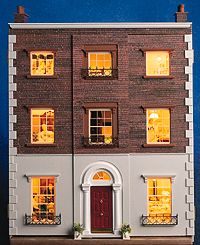
Dolls' House Parade |
"Everything For Your Dolls' House Under One Roof" |
Tel: +44 (0)20 8295 0688 |
History of Dolls' Houses
In the early 1920s a project was hatched to create "the ultimate" dolls house. Queen Mary was an avid collector of miniatures, and a cousin of the King had the idea of building the house and presenting it to the Queen. Sir Edwin Lutyens, a renowned architect of the time, was commissioned for the project. After the initial shock he accepted the unusual request and set about the project with great enthusiasm. "Let us devise and design for all time, something which will enable future generations to see how a King and Queen lived in the twentieth century, and what authors, artists and craftsmen of note there were, during their reign", he was quoted as saying. This nicely summed up the work which was undertaken. After contributions from 1,500 tradesmen, artists and authors the house was finally completed in early 1924 and exhibited at the British Empire Exhibition, to great popular acclaim. Built to 1/12th scale, the dolls house measures 102 inches by 58 inches, and is 60 inches tall. Sir Edwin had to manage a project, which was to involve most of the great tradesmen and artists of the times. Great care went into sourcing the items for the house. The list of famous names contributors is endless - sewing machine from Singer; real Champagne from Veuve Clicquot and Mumm; clocks by Cartier; china by Doulton and even cars from Rolls Royce and Daimler. All were lovingly crafted to 1/12th scale. Sir Arthur Conan Doyle even wrote a short story (500 words) in a miniature book for the library. Exquisite furniture made from exotic woods fills the house - such as the large Victorian wardrobe veneered in amboyna wood, which can be seen in the Queens Suite. A bathroom floor laid in mother of pearl reflects the opulence the dolls house portrays. Still on display in Windsor Castle, and ever popular with the public, this is truly a masterful record of a bygone era. It may be that we can attribute the dolls house hobby, as we know it, to this project. Many people saw the house and were inspired by it to collect there own miniatures. Two of the most well known collectors of the pre war years were Mrs Thorne, creator of the Thorne Rooms in America and Mrs Carlisle in England who also created a series of rooms. Both strove to re-create the ambiance of the periods they represented. Whilst these works were not dolls houses in the true sense of the words, nevertheless they were fine examples of miniature house creation and doubtless also enthused all those who saw them. The hobby was now growing in to that which we see today, and since the 1970s its popularity has continued to grow in leaps and bounds. During the early 1980s another great dolls house was created. West Wood House was created by David West, so large that he even managed to get stuck in it for half an hour, at one stage during the construction. Other large projects are created from time to time, but in general people enjoy the dolls house hobby on a smaller scale, but it is no less rewarding for them because of it. Nowadays the miniature hobbyist has a world of assistance at their fingertips, unlike their earlier "pioneers". Shops throughout the world give easy access to the thousands of items, which go towards the creation of a dolls house. This not only makes it accessible but affordable. Books and magazines can help fire the imagination with ideas and tips. Clubs for dolls house and miniaturist enthusiasts enable ideas to be swapped and enthusiasm to be shared. From those early beginnings in the 16th century we now have a hobby that truly reaches the masses and has "something for everybody"
|
![]()
![]()
|
![]()
The best form of advertising is by word of mouth. Read what people say about Dolls House Parade. |
![]()

 The
earliest records of dolls houses or "baby houses" as
they were also called, date back to the sixteenth century, but
these were exclusive, tending to be replicas of wealthy family
homes and were built as a record of the times rather than for
hobby or play purposes. During the same period wealthy women in
Holland and Germany created miniature houses in a study of contemporary
fashion and décor. During the eighteenth century cabinet
houses began to appear - where a dolls house was created in the
interior of a beautiful cabinet. The "doll cabinet"
of Sara Ploos van Amstel is one of the best-known examples and
this exquisite work dates back to 1745. However, it was not until
the Victorian era in the late 1800s that dolls houses became truly
popular. Though still not seen as a hobby, many a Victorian nursery
rang to the joyful sounds of children playing with the dolls house.
The
earliest records of dolls houses or "baby houses" as
they were also called, date back to the sixteenth century, but
these were exclusive, tending to be replicas of wealthy family
homes and were built as a record of the times rather than for
hobby or play purposes. During the same period wealthy women in
Holland and Germany created miniature houses in a study of contemporary
fashion and décor. During the eighteenth century cabinet
houses began to appear - where a dolls house was created in the
interior of a beautiful cabinet. The "doll cabinet"
of Sara Ploos van Amstel is one of the best-known examples and
this exquisite work dates back to 1745. However, it was not until
the Victorian era in the late 1800s that dolls houses became truly
popular. Though still not seen as a hobby, many a Victorian nursery
rang to the joyful sounds of children playing with the dolls house.


